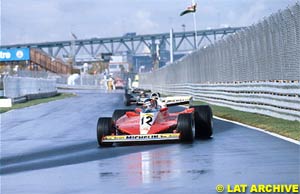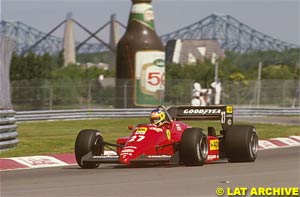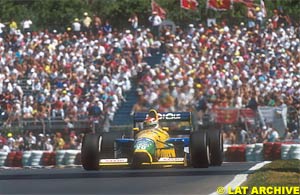
Atlas F1 Contributing Writer
The Circuit Gilles Villeneuve, home of the Canadian Grand Prix since 1978, is a difficult technical challenge, which can genuinely be regarded as one which sorts out The Men from the boys. Journalist and historian Doug Nye looks at the history of the Canadian race and reviews some of the best Grands Prix that have taken place on the Ile Notre Dame track
The Canadian round of the Formula One World Championship series has been held on the Ile Notre Dame course on the St Lawrence river since 1978.
The Grand Prix returned to Mosport as a regular home until financial difficulties saw the event dropped from the calendar in 1975. Almost immediately, however, the emergence on the world Formula One stage of French-Canadian Gilles Villeneuve rekindled the flames of enthusiasm - and the prospects of running a profitable race meeting - in his native land.
The Ile Notre Dame flanked the artificial rowing lake used for the 1976 Olympic Games in Montreal, while in 1967 it had been the site of the Expo '67 world's fair extravaganza for which one leading Formula One team - BRM - had actually built a display H16-cylinder 3-litre F1 car specifically for extended exhibition in the British industry pavilion. Now, with excellent public access infrastructure despite the island - access including a subway system from the Montreal city centre, the Ile Notre Dame motor race circuit really had something special to offer.
The circuit itself was some 2.7-miles in length - 4.42kms - and as it looped and twisted around the perimeter of the lengthy, slightly banana-shaped island, so it offered some truly testing medium- and high-speed corners, interspersed by two hairpins - one tight, one tighter - and a little regulation FIA chicanery.
The circuit opened to Formula One in grand style as the closing round of the 1978 World Championship. Mario Andretti had already long-since sewn-up that series' title in his Lotus 79 ground-effects pioneer, but for the home crowd all eyes were upon Gilles Villeneuve of Ferrari, who fulfilled all their dreams - and his own - in securing his first Formula One victory, and before his nation's Prime Minister, Pierre Trudeau. In their delight at witnessing the Ferrari 'new boy's long-expected debut victory, most forgot the amazing sight of Lotus stand-in driver Jean-Pierre Jarier leading in utterly dominant style until a major oil leak sidelined him after 49 of the scheduled 70 laps. Andretti had collided with John Watson's Brabham-Alfa in the opening stages.
In 1979 the island hosted the penultimate round of the year's title chase. Alan Jones put his Williams FW07 on pole, and fought a wonderful duel with home boy Villeneuve's Ferrari 312T4, slipping ahead after the Maranello car had led for 51 of the now 72-lap distance. Nelson Piquet gave the new Brabham-Cosworth BT49 a rousing outing, chasing the leading duo hard until the gearbox failed - enabling Clay Regazzoni in the second Williams to inherit third place.
Jones and Piquet were the star adversaries back on the island in 1980, locked in bitter combat for the year's World titles. Nelson beat Jonesie to pole position, and the pair tangled in the first corner of the race, triggering a multiple collision which stopped the race. Piquet restarted in Brabham's spare car still fitted with its qualifying 'screamer' engine. Predictably he led until the inevitable detonation, which retired him on lap 24. Didier Pironi of Ligier - carrying a one-minute penalty for having jumped the start - inherited the lead on the road, enabling Jones to sit back in second place and inherit victory - and the Drivers' World Championship title - once the penalty had been added to the Frenchman's time.
That year the race had reverted to 70 laps distance, and notionally it remained at that for 1981, but for heavy and unremitting rain which saw the event flagged-off after the regulation two hours, and only 63 laps completed. Michelin rain tyres proved supreme. Jones spun off in his leading Williams, Alain Prost's Renault developed locking brakes and Jacques Laffite was enabled to plume home to rare victory in the ear-splitting Ligier-Matra V12. John Watson - in second place for McLaren - confirmed the Woking team's fast-improving form.
For 1982, the Canadian race had been moved to the middle of the season as part two of a double-header North American tour linked with the preceding Detroit GP. But Gilles Villeneuve had been killed earlier in the season at Zolder. Didier Pironi qualified his Ferrari 126C2 turbo brilliantly on pole position, but at the start he stalled, and his stationary car was rammed flat-out by the hapless Ricardo Paletti's Osella, accelerating unsighted from the back of the grid. Poor Paletti was killed instantly in the impact. The race was of course red-flagged.
Pironi took the restart in the spare Ferrari, and set fastest race lap, but the Grand Prix proved to be a logistical triumph for Brabham with Nelson Piquet victorious in the Brabham-BMW BT50 turbo from his teammate Ricardo Patrese, second in the sister Cosworth-Ford powered BT49D. John Wattie was third for McLaren - again going well in Canada.
Ferrari fans loved the 1983 Canadian GP - a faultless Ferrari victory by Rene Arnoux in the latest 126C2B turbo car, with teammate Patrick Tambay third, and Eddie Cheever sandwiched between the red cars in second place for Renault. Nelson Piquet retired when running third and Patrese ran second until his car's gearbox failed. Arnoux had qualified on pole, and Tambay set fastest race lap - all the prime performances falling to Maranello's finest…
The island then - in 1985 - witnessed the first Ferrari 1-2 finish since Zandvoort '83. An all-Lotus front row had started the race but Ayrton Senna's Renault-powered Type 97T was delayed by an early turbo problem, Elio de Angelis took off from pole and led for 15 laps before fading, and it was Ferrari fuel economy which enabled Michele Alboreto to win from teammate Stefan Johansson. Alain Prost's late-race charge for McLaren was foiled by de Cesaris's Ligier blocking his path, and he finished third.
The race was cut to 69 laps from 70 in 1986, and a mature drive by Nigel Mansell in his Williams-Honda FW11 saw him secure the fourth victory of his F1 career, balancing speed with restraint. He lapped all his rivals save Prost, Piquet and Rosberg who finished 2-3-4 in McLaren-Williams-McLaren respectively…
There was no Canadian GP in 1987. The lack of Canadian driver interest was a real problem to promoters experiencing serious difficulties in other areas while re-investing in circuit modifications including the new pit complex. But in 1988 their race resumed, still at 69 laps distance, with Senna and Prost 1-2 in the latest McLaren-Honda MP4/4s, and Thierry Boutsen's Benetton-Ford third.
During practice for that 1988 race Derek Warwick survived a nasty-looking accident in his Arrows-BMW at what was then a fast ess-bend approaching the pits area. This section was subsequently re-aligned to provide a very much slower 90-right/90-left ess-bend which demanded really heavy braking at the end of the long approach straight, providing another important overtaking point. Nonetheless it remained a tricky section, with a very hard exit wall, as both Nigel Mansell and Michael Schumacher - and Jacques Villeneuve - would discover to their cost.
Boutsen - the likeable Belgian - went two better in 1989 when it rained again on the island, and he won in his Williams-Renault FW12C from teammate Patrese's sister car - an unexpected Williams 1-2. Patrese had led for a long way - Senna's McLaren blew-up with 3 laps to run - but Derek Warwick had seemed set to score Arrows' first-ever Formula One victory until his engine failed. Prost had led the opening lap, Senna laps 2-3, Patrese 4-34, Warwick 35-38, Senna 39-66, and Boutsen 67-69. It was perhaps the most extraordinary of Montreal GP races.
The 1991 race then witnessed Nigel Mansell's infamous 'waving to the crowd' debacle upon the final lap when he inadvertently allowed the engine of his Williams-Renault FW13B to stall out of the final hairpin when he believed he had the race stone cold won.
He had led from the start after his teammate Patrese had qualified on pole, and the Englishman had also set a handsome fastest lap before this remarkable failure within a mile of the finish. Nelson Piquet - who had been left floundering fully 40 seconds astern - was astonished to find himself flagged home the winner in the Benetton-Ford B191, from Stefano Modena's Tyrrell-Honda 020 and Patrese's Williams which had been delayed by a puncture and unscheduled pit stop. Riccardo Patrese's was a brave race, for he had suffered whiplash in a heavy accident during practice.
And so into the modern era. Major safety modifications were made to the course in 1996 when Gilles Villeneuve's son Jacques made his Formula One debut upon the course bearing his late father's name, finishing second to teammate Damon Hill in the Williams-Renault FW19.
The Circuit Gilles Villeneuve has been described as being "very rewarding to drive when everything clicks together", but it remains a difficult technical challenge, hard on brakes and tyres and one of the few surviving circuits which can genuinely be regarded as one which sorts out The Men from the boys.
A possibly unfortunate comparison for those in the know, but while modern Formula One has been racing 'around the island' in Montreal since 1978, the Canadian Grand Prix race weekend this year follows hard on the heels of the 'Real Man's racing around the island', the motorcycle TT races on the Isle of Man.
 The first World Championship-qualifying Canadian Grand Prix was held at Mosport Park, near Toronto, in 1967. The Canadian motor sporting authorities then alternated the event with Le Circuit Mont Tremblant at Ste Jovite until 1970, when this intensely picturesque venue near Montreal was allowed to lapse into international disuse.
The first World Championship-qualifying Canadian Grand Prix was held at Mosport Park, near Toronto, in 1967. The Canadian motor sporting authorities then alternated the event with Le Circuit Mont Tremblant at Ste Jovite until 1970, when this intensely picturesque venue near Montreal was allowed to lapse into international disuse.
 The new circuit was demanding, fast enough to be interesting, demanding enough to be quite daunting, and at that time it offered good overtaking opportunities for an off-line error in one corner of a flowing sequence could provide great slipstreaming opportunity into a later braking area. Pit and paddock facilities were somewhat Spartan in those early days, and despite standard-style whingeing from both the haves and have-nots of the Formula One world they were eventually replaced by a more palatial pitlane in 1988.
The new circuit was demanding, fast enough to be interesting, demanding enough to be quite daunting, and at that time it offered good overtaking opportunities for an off-line error in one corner of a flowing sequence could provide great slipstreaming opportunity into a later braking area. Pit and paddock facilities were somewhat Spartan in those early days, and despite standard-style whingeing from both the haves and have-nots of the Formula One world they were eventually replaced by a more palatial pitlane in 1988.
 In 1984 the McLaren-TAG Turbo steamroller bored to fuel efficient victory after fuel efficient victory. The Canadian race around the island was moved to immediately after Monaco with Detroit following later. Nobody could touch Piquet in the latest iteration of the Brabham-BMW BT53 'dart' as he started from pole, set fastest race lap and won from the McLaren-TAG twins, Lauda and Prost. In effect the McLarens were first and second as usual - except that this time the mercurial Brabham-BMW 4-cylinder survived to finish ahead of them both.
In 1984 the McLaren-TAG Turbo steamroller bored to fuel efficient victory after fuel efficient victory. The Canadian race around the island was moved to immediately after Monaco with Detroit following later. Nobody could touch Piquet in the latest iteration of the Brabham-BMW BT53 'dart' as he started from pole, set fastest race lap and won from the McLaren-TAG twins, Lauda and Prost. In effect the McLarens were first and second as usual - except that this time the mercurial Brabham-BMW 4-cylinder survived to finish ahead of them both.
 In 1990 Gerhard Berger jumped the start from the outside of the front row in his McLaren-Honda MP4/5B and was penalised one minute. In consequence, teammate Senna simply trailed him all the way to victory, something of a bore.
In 1990 Gerhard Berger jumped the start from the outside of the front row in his McLaren-Honda MP4/5B and was penalised one minute. In consequence, teammate Senna simply trailed him all the way to victory, something of a bore.
Please Contact Us for permission to republish this or any other material from Atlas F1.
|
Volume 8, Issue 23
Atlas F1 Exclusive
Interview with Dickie Stanford
Jo Ramirez: a Racing Man
Articles
Blind Spot for Bernoldi
Canadian GP Preview
Canadian GP Preview
Local History: Canadian GP
Canada Stats and Facts
Technical Focus: Tyre Technology
Columns
The Canadian GP Quiz
Bookworm Critique
Elsewhere in Racing
The Grapevine
> Homepage |